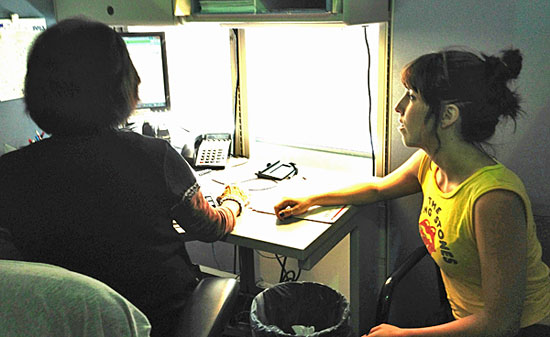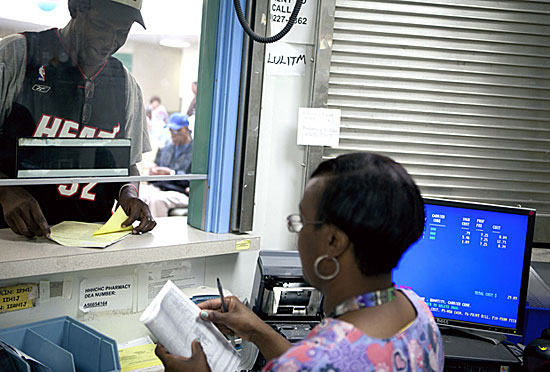‘Healthy’ shortcut to medical care
October 9, 2013

Patient Beth Goodfellow likes the Affordable Care Act, but for now, she’s relying on Healthy Way L.A.
As Californians rushed to sign up for coverage under the Affordable Care Act last week, Beth Goodfellow sat on the sidelines, too sick to join in.
A 28-year-old rock musician newly arrived in Atwater Village from San Francisco, she had planned to wait until her gigs picked up and then shop on the new state exchange for health insurance. But when a pain in her side wouldn’t go away, she found herself at the county’s Mid-Valley Comprehensive Health Care Center, unable to wait until 2014, when the Affordable Care Act kicks in in earnest.
The county’s Rx?
A primary care doctor at the Van Nuys center, and enrollment—right now—in Healthy Way L.A.
As the next phase of healthcare reform approaches a January deadline, Los Angeles County has been busily bridging the gap with its own interim program to channel the uninsured toward coverage.
Come 2014, all Americans will be required to have some form of health insurance, whether via an employer, a private purchase or the government—Medicare or Medicaid, for example.
To ease the shift, that mandate will come not only with subsidized state exchanges like the ones that opened last week to make it easier and cheaper to buy private insurance, but also with a massive expansion of the federal government’s Medicaid program for low-income patients, (or Medi-Cal, as it is known in this state).
While computer glitches with the exchanges have drawn widespread attention nationwide in the past week, Los Angeles County has continued to power ahead with a related effort: enrolling as many eligible uninsured patients as possible in a local program called Healthy Way L.A.
Created in 2007, Healthy Way L.A. isn’t technically health insurance and, except for emergency services, doesn’t cover members outside Los Angeles County. But it does offer free, publicly funded health care to the kinds of patients who mostly end up being treated by the county and community clinics—those who can’t afford private insurance, or whose jobs don’t include it.
The program covers legal residents aged 19 to 64 who earn too much to qualify for Medi-Cal right now and still make less than 133% of the federal poverty level (less than about $1,274 monthly for one person). Because all of those patients will become eligible for government-subsidized insurance under the terms of next year’s expansion, health officials are viewing Healthy Way L.A. as a quick and easy steppingstone to the new, more broad-based version of Medi-Cal.
Thousands of uninsured patients have been registered for Healthy Way L.A. at health fairs, county hospitals and health care centers and community clinics, and, as January approaches, the county has moved aggressively.
Dr. Mitchell Katz, director of the county’s Department of Health Services, told the Board of Supervisors on Tuesday that the county is well on its way toward reaching its goal of 300,000 sign-ups for the program.
Sheryl Spiller, head of the county’s Department of Public Social Services, which is playing a central role in registering people for the program, told supervisors that 275,000 already have been signed up.
“Things are moving along and we’re ready,” Spiller said.
The stakes are high, both for patients and the county.
Giving patients a fast track to insurance gets them accustomed to regular checkups at a regular location. That, in turn, helps keep them healthier and holds down healthcare costs by preventing expensive emergency room visits.
But another reason for the push is that the county wants these patients. When the Healthy Way L.A. clients transition to Medi-Cal, the federal government will begin picking up all or most of the cost of their healthcare—a tab that the county is helping to pick up currently.
Moreover, even with the Affordable Care Act, the county will remain the provider of last resort for some 400,000 undocumented residents and others who will remain ineligible for any insurance. The county will need as many covered patients as possible to stay financially afloat
So with only a couple months until January, the county is pulling out all the stops to get future Medi-Cal recipients into the pipeline.
“It’s crunch time,” said Deedra Williams, public information officer for ambulatory care at the Department of Health Services. “It’s all hands on deck right now.”
Goodfellow, the rock musician, was one of 38 new clients signed up on a single morning last week at the healthcare center in Van Nuys.
And there as elsewhere, officials say the county has been working on its bedside manner, because under Medi-Cal, the Healthy Way L.A. clients who now get their care from county doctors and community partners will be able to shop around for healthcare.
“We’ve been serving this population for two years now, but we’re focusing on making sure that we provide quality care and good customer service,” said Tangerine Brigham, DHS deputy director of managed care services.
DHS officials say the department has been working with Spanish-language television stations to get the word out, and last week, DHS rolled out a new, much more user-friendly web site. And at Mid-Valley, Associate Administrator Linda Kim-Fung said staffers last year underwent intensive customer service training.
“We’re trying to educate our staff to go out of their way to be friendly,” Kim-Fung said. “You know—the customer comes first, be friendly, ask if there’s anything else.”
That’s a good thing, said 52-year-old Ben Ahmadi, an uninsured grocery clerk with diabetes who was renewing his Healthy Way L.A. enrollment.
“There’s nothing wrong with the doctors here,” he said. But, he added, the county system will have its work cut out for it if it wants to compete with established managed health care juggernauts such as Kaiser Permanente, where he once had insurance.
“When I used to have Kaiser, you’d go in and make an appointment and you’d be in there in around 15 minutes,” he said.
Goodfellow said she’s grateful that Healthy Way L.A. was there to cover her in the short term. In San Francisco, she said, she used a similar county health access program and was pleasantly surprised at the quality of care.
“I’m pretty young, so I just tend to go to the doctor when I don’t feel well,” she said. “But I think Obamacare is a really good idea and I’m happy we’re coming closer to having health care for everyone.”
Posted 10/8/13













 405 bridge work causes a stink
405 bridge work causes a stink
